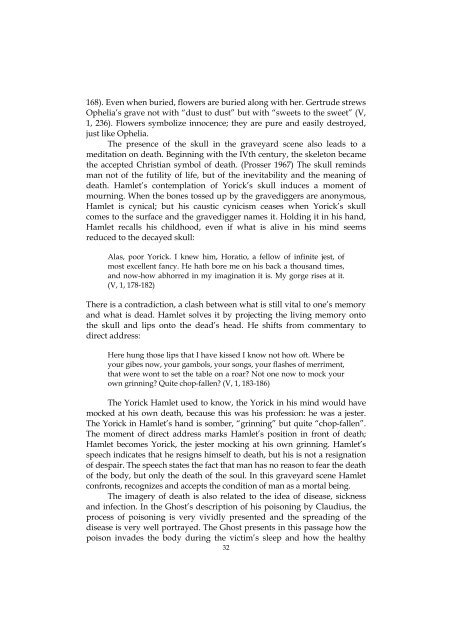translation studies. retrospective and prospective views
translation studies. retrospective and prospective views
translation studies. retrospective and prospective views
Create successful ePaper yourself
Turn your PDF publications into a flip-book with our unique Google optimized e-Paper software.
168). Even when buried, flowers are buried along with her. Gertrude strews<br />
Ophelia’s grave not with “dust to dust” but with “sweets to the sweet” (V,<br />
1, 236). Flowers symbolize innocence; they are pure <strong>and</strong> easily destroyed,<br />
just like Ophelia.<br />
The presence of the skull in the graveyard scene also leads to a<br />
meditation on death. Beginning with the IVth century, the skeleton became<br />
the accepted Christian symbol of death. (Prosser 1967) The skull reminds<br />
man not of the futility of life, but of the inevitability <strong>and</strong> the meaning of<br />
death. Hamlet’s contemplation of Yorick’s skull induces a moment of<br />
mourning. When the bones tossed up by the gravediggers are anonymous,<br />
Hamlet is cynical; but his caustic cynicism ceases when Yorick’s skull<br />
comes to the surface <strong>and</strong> the gravedigger names it. Holding it in his h<strong>and</strong>,<br />
Hamlet recalls his childhood, even if what is alive in his mind seems<br />
reduced to the decayed skull:<br />
Alas, poor Yorick. I knew him, Horatio, a fellow of infinite jest, of<br />
most excellent fancy. He hath bore me on his back a thous<strong>and</strong> times,<br />
<strong>and</strong> now-how abhorred in my imagination it is. My gorge rises at it.<br />
(V, 1, 178-182)<br />
There is a contradiction, a clash between what is still vital to one’s memory<br />
<strong>and</strong> what is dead. Hamlet solves it by projecting the living memory onto<br />
the skull <strong>and</strong> lips onto the dead’s head. He shifts from commentary to<br />
direct address:<br />
Here hung those lips that I have kissed I know not how oft. Where be<br />
your gibes now, your gambols, your songs, your flashes of merriment,<br />
that were wont to set the table on a roar? Not one now to mock your<br />
own grinning? Quite chop-fallen? (V, 1, 183-186)<br />
The Yorick Hamlet used to know, the Yorick in his mind would have<br />
mocked at his own death, because this was his profession: he was a jester.<br />
The Yorick in Hamlet’s h<strong>and</strong> is somber, “grinning” but quite “chop-fallen”.<br />
The moment of direct address marks Hamlet’s position in front of death;<br />
Hamlet becomes Yorick, the jester mocking at his own grinning. Hamlet’s<br />
speech indicates that he resigns himself to death, but his is not a resignation<br />
of despair. The speech states the fact that man has no reason to fear the death<br />
of the body, but only the death of the soul. In this graveyard scene Hamlet<br />
confronts, recognizes <strong>and</strong> accepts the condition of man as a mortal being.<br />
The imagery of death is also related to the idea of disease, sickness<br />
<strong>and</strong> infection. In the Ghost’s description of his poisoning by Claudius, the<br />
process of poisoning is very vividly presented <strong>and</strong> the spreading of the<br />
disease is very well portrayed. The Ghost presents in this passage how the<br />
poison invades the body during the victim’s sleep <strong>and</strong> how the healthy<br />
32












